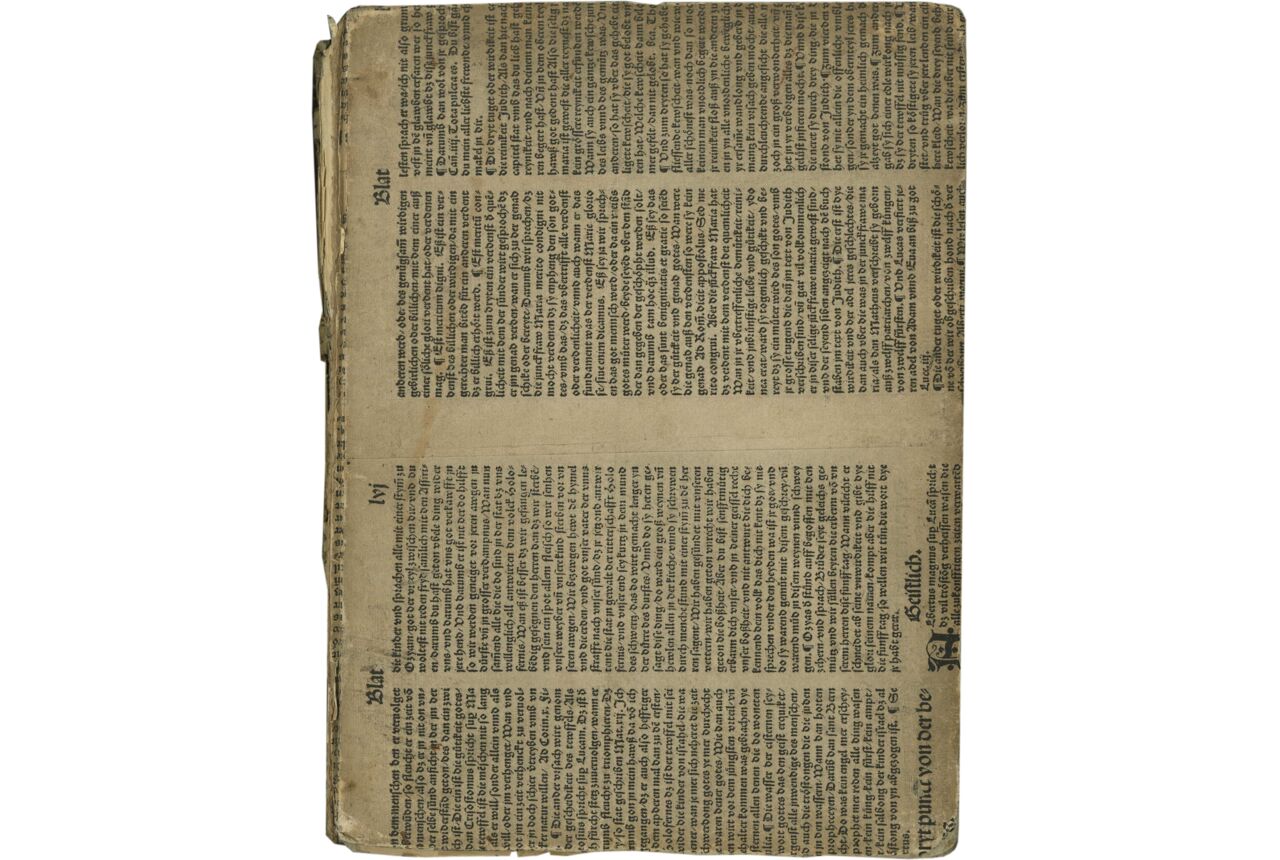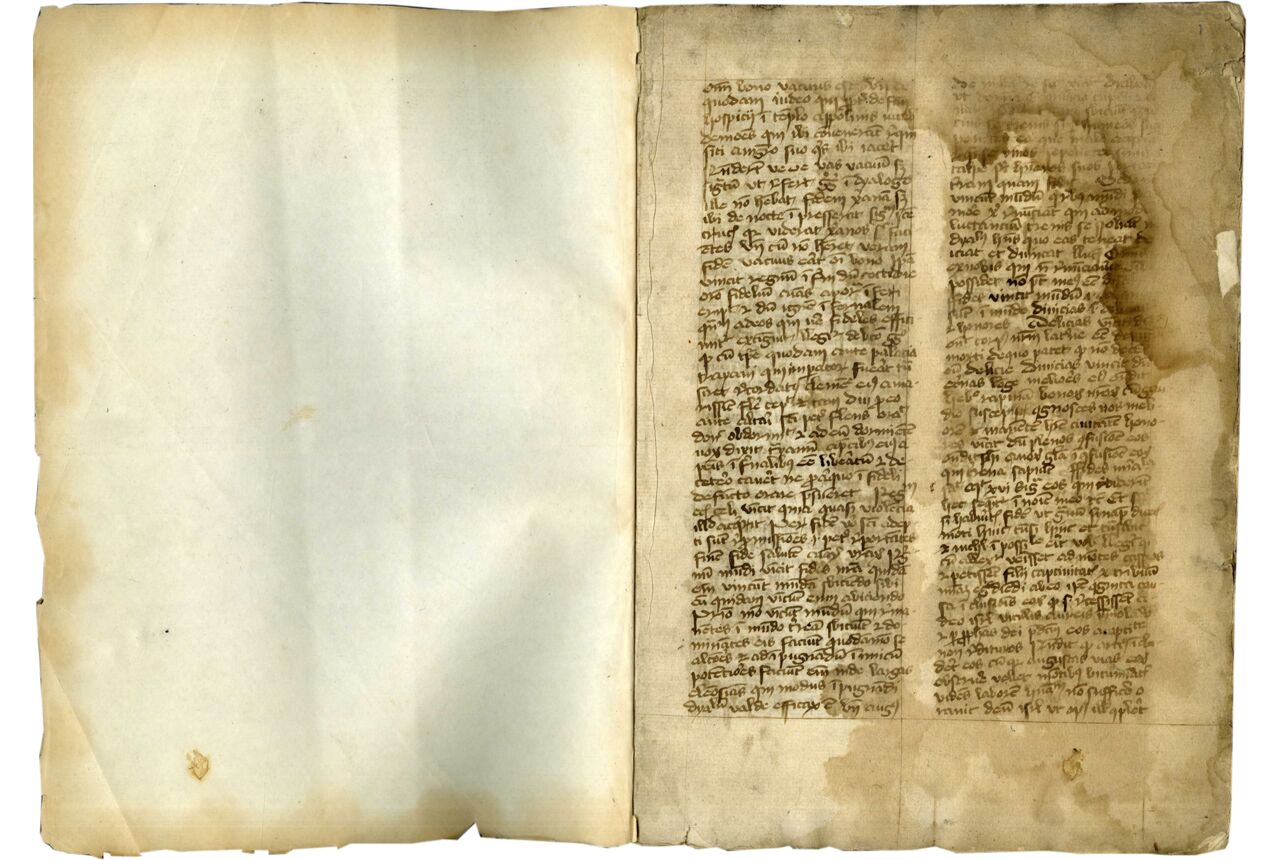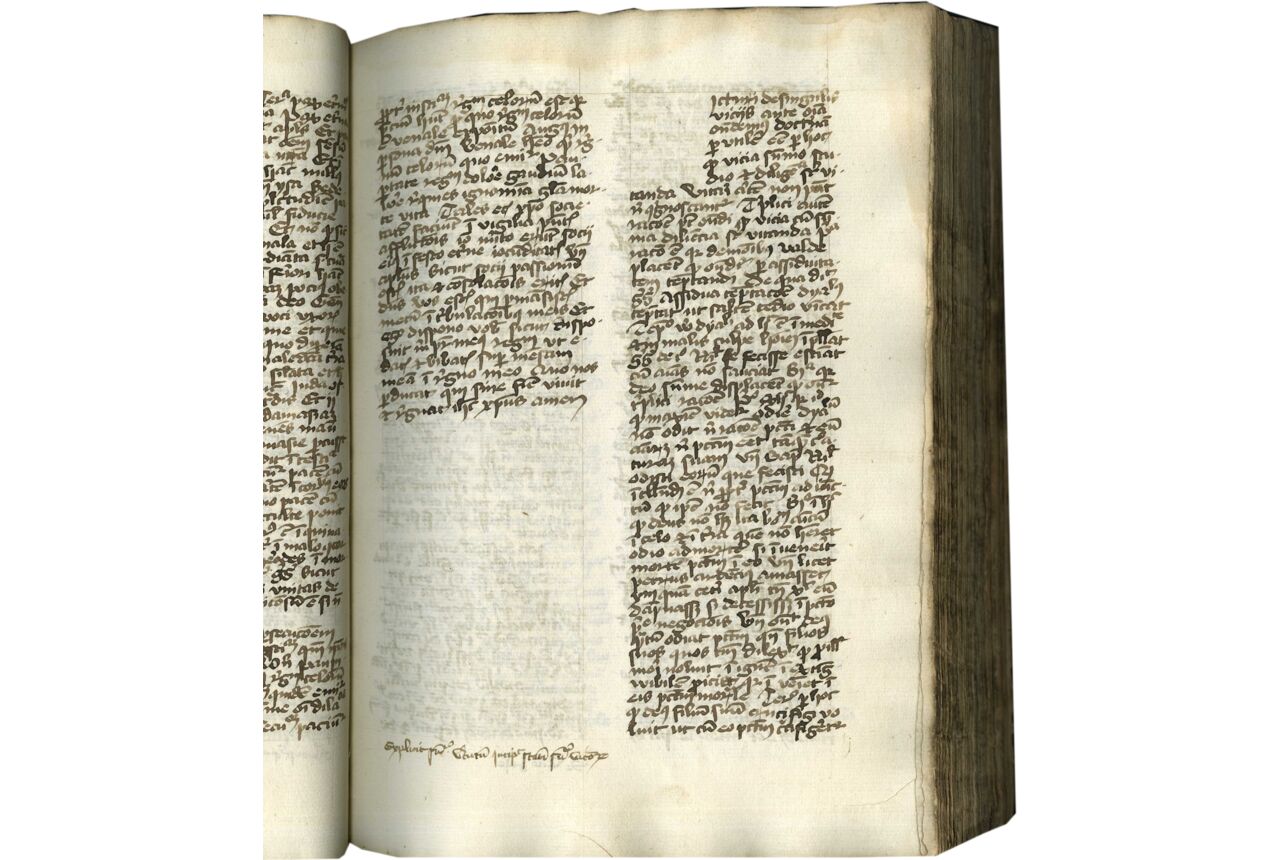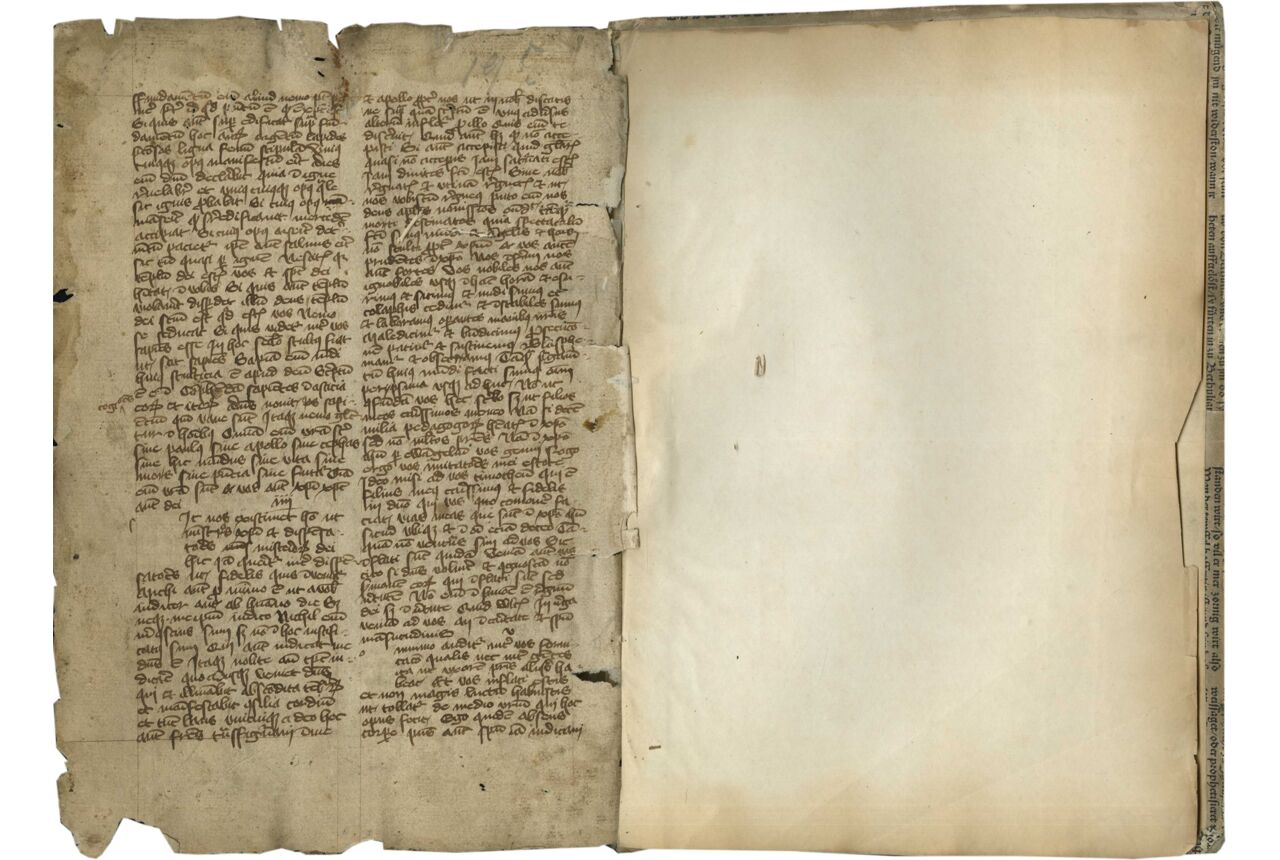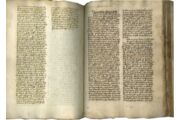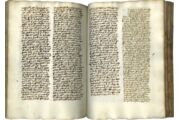i (modern paper) + 222 + i (modern paper) folios on paper, watermarks similar to Briquet no. 14514, Tête de bœuf: Zurich, 1424-1425; Briquet no. 2759, Bœuf: Bergamo, 1437; Briquet nos. 829 and 831, Arc: Lanzo [Piedmont], 1403, Grenoble, 1402-1420, Saint-Bonnet-le-Château, 1402, Valentinois, after 1403, Saint-Marcellin, 1405-1415, Lyon, 1406, Montbrison, 1409 and 1445/48, Bern, 1416, Romans-sur-Isère, 1421, Rodez, 1423, Solothurn, 1441; Briquet no. 4634, Couronne: Harlem, 1421, Lautrec, 1417-1425, Geneva, 1420/21, Fribourg, 1421, Colmar, 1423, Babenhausen, 1425, Toulouse, 1425, Avignon, 1426, Orléans, 1426, modern foliation in pencil, upper outer recto, 1-222, with losses of text at the beginning and ending (collation I. ff. 1-138v, i12 [-1 -2 -3, with loss of text] ii-xi12 xii12 [-10 -11 -12; cancelled with no loss of text]; II. ff. 139-162v, xiii-xiv12; III. ff. 163-222v, xv-xix12), quires ii-v numbered, front upper recto, “Secundus” to “Quintus,”quires vi-xii numbered in Roman numerals, front upper recto, vj-xij, quires xv-xviii have horizontal catchwords, inner lower verso, parchment reinforcement strip for quire xix retains faint traces of script, ruled throughout in brown ink in two columns, layout varies, I. ff. 1-138v, ruled with full-length horizontal and vertical bounding lines, prickings visible in outer and lower margins (justification 223-232 x 155-160 mm.), written in a rapid Gothic cursive script on forty-one to forty-seven lines, guide notes for rubrics that were never completed, one- to four-line spaces left for initials, some guide letters for initials, six-line space left for an initial (f. 56); II. ff. 139-162v, ruled with full-length vertical bounding lines (justification 235-240 x 146-158 mm.), written in three different Gothic cursive hands: (1) ff. 139-152, in brown ink in a script with some spikiness on thirty-five to fifty-two lines, rubrics by the scribe in brown ink, often preceded by one-line brown paraphs, one- to two-line spaces left for initials, marginal references to biblical sources in scribe’s hand, (2) ff. 152v-155, in dark brown ink in a rapid script on forty to forty-one lines, three-line initial, added by the scribe(?), and (3) ff. 155-162v, in light brown ink in a highly compressed script on fifty-two to fifty-five lines, three- to four-line blank spaces for initials, pointing hand f. 160v; III. ff. 163-222v, ruled with full-length horizontal and vertical bounding lines, prickings three outer margins (justification 228-232 x 157-159 mm.), written in two Gothic cursive hands: (1) ff. 163-213v, in a fine calligraphic script with some cursiva antiquior characteristics on forty-seven to fifty-one lines, some guide letters for initials, blank spaces for rubrics and initials, followed by opening lines in a larger Gothic display script (ff. 163, 174, 184, 196v), and (2) ff. 214-222v, in looser script on forty-two to forty-seven lines, three- to six-line spaces left for initials, some guide letters, rubrics on f. 221v written in larger display script; some cropping of the outer margin (see f. 153v), minor staining and smudging (see f. 213v in particular), dampstaining of the upper and upper outer margins of the rear and front leaves, with some loss of legibility on ff. 1-9, some tearing along the inner margins of ff. 221 and 222 and damage to the outer edges of f. 222, with no loss of text. Detached binding of pasteboard with leaves from a sixteenth-century German imprint (see below, in Provenance) on the sides and spine, with paper flaking along the joints and edges and with front board completely detached from spine, remains of earlier binding of worn brown leather underneath in an intact spine with four double bands, with two paper labels, one inscribed “125” and the other, partially torn away, inscribed “manuscrit //”. Dimensions 297 x 217 mm.
Although most of the texts in this miscellany are not in themselves rare (excepting the two commentaries on Peter Lombard’s Sentences), the collection itself is interesting, for it includes an intriguing combination of works of central concern to the Dominican Order. Its large size, atypical of Dominican miscellanies, points to an origin in a Dominican house of studies, for use by friars in both university and pastoral contexts. William of Peraldus’s popular treatise on the Virtues and Vices, forming the core of the manuscript, still lacks a modern critical edition.
Provenance
1. Though this manuscript is fairly homogeneous in its appearance and probable place and date of origin, there is reason to believe that it was copied over several decades in the first half of the fifteenth century, and assembled from three discrete booklets. Judging from evidence of their various watermarks, scripts, and orthographies, all three booklets were produced in the first half of the fifteenth century, likely in the region of the Upper Rhine. Notably, the scribes of the second booklet and the primary scribe of the third booklet all exhibit features of script (notable in the treatment of the double “ij” like a dotted “y”) or orthography (“ewangelium,” “wlnerato”) suggestive of an origin in a German-speaking region around the Upper Rhine.
There are some indications that the third booklet may have been produced slightly earlier than the other two. Specifically, conservative features in its script (notably a compressed “g” that practically stands on the baseline and a flourish to the right in the final curve of “m” and “n”) and the dating of its watermarks both suggest that this booklet was most likely produced in the first quarter of the fifteenth-century. The watermarks of the first two booklets, on the other hand, suggest that they were produced in the second quarter of the fifteenth century.
The manuscript’s contents, when taken as a whole, strongly indicate that this book was compiled for the use of a mendicant friar, possibly one connected to a Dominican studium (see below, in the Text section). Its comparatively large dimensions and the neat but informal presentation of the texts are all what we might expect of a schoolbook produced in-house. Further study of the manuscript’s contents, particularly those that have not been identified elsewhere, may shed more light on the book’s origins and early use.
2. The fragmentary label on the spine, referring to the present volume as a “manuscrit,” indicates that this book was bound or subsequently owned in a Francophone region. Given the evidence that it may subsequently have returned to a German-speaking region (see below, in Provenance), it may not have traveled far from the Upper Rhine.
3. The use of an early German imprint covering the boards with which this manuscript was subsequently bound may indicate that the book had traveled east since the time of its earlier binding. All of the pages used in this binding have been taken from the same imprint, the second volume of Der beschlossen gart des rosenkrantz Marie, a work of late medieval piety that was printed in Nuremberg in 1505 and has been attributed to Johann Henlein, prior of Nuremberg’s Dominicans (Santing, 2003, p. 215). The pages used in the binding are consecutively bound leaves rather than uncut sheets: ff. liiij and lv have been used on the back board, ff. lvj and lvij have been used on the front board, and ff. lviij and lix have been used on the spine.
Text
I. ff. 1-138v:
ff. 1-56, beginning imperfectly, “// omni bono vacuus est ... [f. 1v] ... [N]otandum quod inter credenda quedam sunt de deo quedam de alijs ... vt edatis et bibatis super mensam mean in regno meo Quo nos perducat quj sine fine viuit et regnat ihesu christus amen. Explicit summa virtutum”;
The Summa de virtutibus of William Peraldus followed his Summa de vitiis, and went into circulation with the earlier text around 1249-1250. There is no modern critical edition of this text. De virtutibus was an immensely popular text in the Middle Ages, surviving on its own or with De vitiis in full or abbreviated form in over 360 manuscripts (Kaeppeli, 1975, no. 1622; see also Bloomfield et al., 1979, no. 5601); first printed in 1469 in Basel, and then alone or with De vitiis in at least seven subsequent editions (Gesamtkatalog der Wiegendrucke 12049-50, 12054-7). A brief collation of the text in the present manuscript with the 1479 edition indicates a significant loss of text at the opening and notable textual variation, possibly indicating that the present manuscript contains an abridged or variant version of De virtutibus.
William Peraldus (c. 1200-1271), a Dominican preacher and writer, studied at the University of Paris and later became prior of the Dominican order at Lyon. Peraldus’s Summa, a compilation of treatises addressing sins and the virtues that were considered their theological opposites, provided confessors with the means of identifying these sins and virtues and preachers with exempla and other materials with which to preach upon them. Peraldus’s Summa quickly became an important handbook in the pastoral work of the mendicant orders and particularly of his fellow Dominicans, and it was included by Humbert of Romans in his list of books that should be held in every Dominican conventual library (Mulchahey, 1998, p. 541).
ff. 56-138v, Incipit statim summa viciorum, incipit, “[D]icturi de singulis vicijs ante omnia ostendemus doctrinam perutilem esse per hoc ... Religio vbi non seruatur silencium potest dicere illud Job xxxo Quasi rupto muro et aperta iunua [sic] irruerunt super me etc. Nescio plus. [added in a smaller contemporary script:] Et sic est finis presentis liber[?] summa deitas immensa bonitas clementissima atque gloriosissima trinitas dilectio Amor caritas sit benedicta in secula seculorum Amen”;
William Peraldus wrote his Summa de vitiis around 1236. There is no modern critical edition of this text, though the online Peraldus Project (Online Resources) offers a partial text normalized from a printed edition and is being produced in conjunction with a critical edition and translation of the text (William Peraldus, Summa on the Vices, in Online Resources). De vitiis was an immensely popular text in the Middle Ages, surviving on its own or with De virtutibus in full or abbreviated form in over 500 manuscripts (Kaeppeli, 1975, no. 1622; see also Bloomfield et al., 1979, no. 1628); first printed Basel, 1469, and then alone or with De virtutibus in at least eight subsequent editions (Gesamtkatalog der Wiegendrucke 12051-7). The version of De vitiis in the present manuscript begins with a variant opening of the text (Bloomfield, 1979, no. 1626) and a brief comparison of the text in the present manuscript with that of the 1474/75 edition reveals textual variation and abridgment.
The incipit of the concluding prayer (“Summa deitas immensa bonitas ...”) has also identified in an early fifteenth-century English manuscript (Christies sale 1584, lot 12 [16 July 2014]), where it has been added following a copy of The Mirror of Recluses.
II. ff. 139-162v:
ff. 139-152, Incipit liber de miseria et vilitate humane nature editus a domino pape innocentio tercio etc., incipit, “[D]omino patri karissimo petro dei gracia portusiensi episcopo lotarius indignus diaconus graciam in presenti et gloriam in futuro ... ut per illud humilis exaltetur”; f. 139, [Book One] De miseria hominis Jeremias, incipit, “[Q]vare de vulua matris egressus sum ... lapas [sic] contenta apud cogitationes diuitum etc”; f. 143v, Incipit particula[?] secunda, incipit, “[T]ria maxime solent affectare homines ... ita peccatores peribunt”; f. 149, Tercia pars, de putredine cadauerum, incipit, “[E]xibit spiritus eius et reuertetur in terram suam ... sulphur et ignis ardens In secula seculorum Amen”;
De miseria humanae conditionis was written in 1195 by Cardinal Lotario dei Segni, later Pope Innocent III. The text has been edited in two modern editions. Maccarone (1955) bases his edition, which seeks to reconstruct the author’s original text, on ten manuscripts dating from the end of the twelfth century to the middle of the fourteenth century. He provides in his preface a partial list of 435 manuscripts and early editions that contain the De miseria (pp. X-XXII). Lewis (1978) instead presents an edition of the text as it commonly circulated in England during the Middle Ages, with translation, and includes an extensive survey of 672 manuscripts (pp. 236-253), in which this manuscript is not included. The text is also printed PL, vol. 217, cols. 701-746. The text in this manuscript follows that of Lewis’s edition very closely, with only minor variations in Book Two, chapters 10 and 11, here compressed into a single chapter. De miseria humanae conditionis was issued in more than fifty printed editions by the middle of the seventeenth century and was translated into nearly every European language. Modern English translations appear in Howard and Dietz (1969) and Lewis (1978).
Lotario dei Segni, the son of Trasimund, count of Segni, was born c. 1160, and died in Perugia in 1216 (Moore, 2003, and Pennington, Online Resources). After his early education in Rome, he studied theology in Paris in the late 1170s or 1180s, and then probably studied law in Bologna. He was elected pope in 1198, when he was only thirty-seven, and took the name Innocent III. He was one of the greatest medieval popes, not only working tirelessly to reform the Roman curia and to reestablish and expand papal authority over the Papal States, but also expanding the role of the Papacy in secular affairs. Before rising to the papacy, Lotario wrote De miseria humanae conditionis and two short theological treatises on the Mass and on marriage, De sacro altaris mysterio and De quadrapartita specie nuptiarum. De miseria was to have been followed by a treatise on the dignity of the human condition – it was never written, presumably because of Lotario’s election as pope – “so that, as in the present work the proud man is brought low, in that [work] the humble man will be exalted” (ed. Howard and Dietz, 1969, p. 3).
f. 152, incipit, “Ieronimus in annalibus hebreorum invenit signa xv dierum ante diem judicij ... et in valle iosaphat iudicabitur omnis homo angelis congregantibus eos”;
The Fifteen Signs of Doomsday, chapter 141 in Peter Comestor’s Historia scholastic; printed PL, vol. 198, col. 1611.
ff. 152v-155, [added in a different contemporary hand: “Sermo sine locutio[?] parabosa [sic] de incarnatione christi, Et de dignitate humane nature ultra angelicam”] incipit, “Aperiam in parabolis os meum et loquar proposiciones ab initio [Psalm 77:2] verba hec scribuntur in libro psalmorum originaliter ... Et se copulata est virgo maria deo etc”;
Anonymous sermon (not identified in Schneyer, 1969-1900).
ff. 155-158, [De dignitate humane nature ultra angelicam] incipit, “[N]am incarnatio filii dei valde consolatoria est humane nature ... patet in arboribus Ideo dicit ewangelium qui se humiliat exaltabitur Qui nobis concedit Amen”;
This unidentified text contains four chapters addressing the dignity of the human condition, with particular attention to Christ’s incarnation and resurrection. This text offers a counterbalance to De miseria humanae conditionis (placed earlier within the same booklet, but not in the same hand) in the same terms as the treatise with which Lotario dei Segni himself had meant to follow De miseria.
f. 158, incipit, “Narrat fulgentius de gestis romanorum in quodam libro ... verus amor debet esse perseuerans non solum in vita sed etiam in morte”;
Selected moralitas on true love, extracted from the Moralitates of Robert Holcot (d. 1349), a Dominican philosopher and theologian who studied and taught at Oxford. He produced his Moralitates, a collection of exempla intended for preachers, later in life. The text here follows that of the 1586 Basel edition fairly closely (see transcription from this edition in Lievens, 2012, pp. 183-184).
ff. 158-159, incipit, “[V]Oca operarios et redde illis mercedem Mt 20 [Matthew 20:8] [...?] sed operarius mercenarius ad hoc non conducitur ... requies eterne contemplacionis etc.
Anonymous sermon (not identified in Schneyer, 1969-1990).
ff. 159-161, incipit, “[N]Ota cura gregis necessaria est tam in vita quam in morte ... nisi sedi apostolice se presentet”;
Brief text on the necessity of pastoral care.
f. 161rv, incipit, “[Q]Veritur quare diuina prouidentia ordinauit peccatum ... totus mundus efficietur reprobus sic [er]go[?] tollerabatur”;
Questio on the subject of divine providence and sin.
f. 161v, incipit, “[D]Octrina t[...?] curatorum consistit in duobus In disciplina correctionis et sermone predicacionis ... Si offers munus tuum ante altare etc.
Excerpt from “De doctrina ordinandorum,” Book 3, titulus 9 in the Summa de poenitentia of Raymond of Peñafort (c. 1180-1275), patron saint of lawyers and a noted Dominican canonist.
f. 161v, incipit, “[C]Irca doctrina predicationis terci sunt consideranda ... et in monte discipulis loquebatur. Mt vo”;
Brief text on the teaching of preaching.
ff. 161v-162, incipit, “[V]Enit filius hominis querere et saluum facere quod perierat Luc 19 [Luke 19:10] Dominus noster ihesus christe ad hoc uenit ut nos per mortem ... mori in cruce et hoc propter caritatem seu ex caritate”;
Anonymous sermon (not identified in Schneyer, 1969-1990).
f. 162rv, incipit, “[M]Isericordia et veritas obuiauerunt sibi iusticia et pax osculate sunt [Psalm 84:11]. Deinde legimus quod quidam paterfamilias ... Sic coniunget seu pacificet nos Ihesus christus filius marie virginis. Amen”;
Schneyer has identified a similar, anonymous sermon in Vorau, Stiftsbibliothek, MS 161, a fourteenth-century manuscript (Schneyer, 1969-90, vol. 9, p. 830, no. 17).
III. ff. 163-222v:
ff. 163-212v, [added in a different contemporary hand: “Lectura breuis boneuenture [sic] super sententias”] incipit, “[C]Vpientes aliquid de penuria etc. vt autem reddit auditorem beniuolum primo ponit vnam causam mouentem ipsum ad compilacionem huius operis ... diuersis causis possunt sanctis placere et displicere. In fine vero epilogat et imponit finem huic operi primo libro etc”; f. 174, incipit, “[C]Reacionem rerum insinuans etc. Vbi primo sic procedit magister primo proponens quod ex auctoritate genesis ... ad verbi incarnati misterium pertinent. Et in hoc terminatur sententia huius secundi libri”; f. 184, incipit, “[C]Vm autem venit et cetera. In hoc tercio libro magister determinat de sacramento incarnationis ... hic sacramenta conferunt graciam ibi autem non. Consequenter recapitula[?] que dixerat et continuat se ad sequencia. Et in hec terminatur finis libri[?] tercij”; f. 196v, incipit, “[S]Amaritanus wlnerato approprians etc. Primo proponit sub parabola sauciati ... et finis ad quem ordinantur omnia. Cui est honor et gloria decus et imperium In secula seculorum Amen. Et sic exest lectura bonauenture cardinalis quattuor librorum sententiarum in abreuiatis pro quo sit benedictus filius virginis marie et in evum Amen etc”;
Commentaries on the Libri Quattuor Sententiarum of Peter Lombard (c. 1100-1160), here attributed to Bonaventure. The commentaries on the first, second, and fourth books of the Sentences are actually the work of Jacobus of Lausanne (d. 1321), a Dominican preacher and superior of the Dominican province of France (see Stegmüller, 1947, no. 386 and Kaeppeli, 1975, pp. 323-324). The commentary on the third book of the Sentences is the work of Jacobus Capocci of Viterbo (c. 1255-1308), an Augustinian friar, a student of Giles of Rome, and the archbishop first of Benevento and then of Naples (see Stegmüller, 1947, no. 390). Both Jacobus of Lausanne and Capocci studied at the Faculty of Theology of the University of Paris where the Sentences were required reading. Stegmüller (1947) and Kaeppeli (1975) list three manuscripts containing the commentaries of Jacobus of Lausanne, though there is at least one additional manuscript – Augsburg, Universitätsbibliothek, Cod. II.1.2o 112, produced in the early fifteenth century, possibly in Nuremberg – that contains the commentaries and shares the same variant opening of the commentary on the fourth book that appears in the present manuscript as well. Stegmüller (1947) lists ten manuscripts containing the commentaries of Capocci.
It is noteworthy that this manuscript combines the commentaries of two different masters. Stegmüller’s lists indicate no instances in which their commentaries appeared in the same manuscript, much less in this apparently unique combined form, though he does indicate several instances in which manuscripts preserve commentaries by Capocci on only three books of the Sentences. The commentaries presented here are likely abbreviated, as the added rubric notes.
ff. 212v-213, incipit, “Sunt tamen nonnulli articuli subscripti In quibus magistro petro de lombarda communiter non consentitur ... Quintus decimus dicit delectacionem morsam esse mortale peccatum etiam si consensum fiat libro secundo distinctio xxiiij c[apitulo?] Quando”;
A list of fifteen points of disagreement with Peter Lombard’s Sentences. Similar lists appear to be found in Paris, Bibliothèque Mazarine, MS 756; Laon, Biblothèque municipal, MS 463; as well as our TM 772, a thirteenth-century copy of the Sentences.
Although the Sentences was the basic theology text for the University of Paris, there were occasional objections raised to specific passages. In the thirteenth century, for example, the University of Paris refused its assent to eight propositions, all of a highly technical character. It would be of interest to compare the objections raised in the thirteenth century with the list in this manuscript.
f. 213rv, incipit, “Error fotini de Incarnacione christi sequentis ebyonem[?] ... relinquis quod post partum non fuerit cognita”;
A list of condemned heresies and their points of divergence from orthodox belief.
f. 213v, incipit, “Nota de penitencia et satisfaccione Quod pisanus in summa sua querit ... contra futuram culpam”;
A list of observations on penitence and satisfaction drawn from the Summa de casibus conscientiae of Bartholomaeus de San Concordio (c. 1260-1347). Bartholomaeus’s Summa is a manual of canon law that enjoyed great popularity on account of its practical application as a manual for confessions.
ff. 214-221v, [added in a different contemporary hand: Epistola pauli ad romanos] Incipit argumentum sancti Jeronimj in solam epistolam sancti apostoli pauli ad romanos, incipit, “[E]Pistole pauli ad romanos causa hec est ... [Stegmüller, 1976-80, 651]”; f. 214, Aliud argumentum in omnes epistolas, incipit, “[P]Auli apostoli epistole sunt numero quatuordecimj ... [Stegmüller, 1976-80, 651]”; f. 214, [I]Ncipit prefatio sancti Jeronimj presbyterus [sic] in corpore epistolarum sancti pauli apostoli, incipit, “[P]Rimum queritur quare post ewangelia que supplementum legis sunt ... [Stegmüller, 1976-80, 670]”; f. 215, Item alia prefacio, incipit, “[R]Omanj sunt partis [sic] ytalie ... [Stegmüller, 1976-80, 677] Explicit prefacio”; f. 215, Incipit epistola beati pauli apostoli ad romanos, incipit, “[P]Aulus seruus ihesu christi vocatus apostolus segregatus in ewangelium dei ... soli dei sapienti per ihesu christum cuj est gloria et honor in secula seculorum etc. Amen”;
Epistle of Paul to the Romans, preceded by several prefaces.
ff. 221v-222v, Incipit argumentum in epistolam primam ad Corinthi, incipit, “[C]Orinthi sunt archaiaci [sic] et hij similiter ab apostolo audierunt ... [Stegmüller, 1976-80, 684]”; f. 221v, Incipiunt epostole ad corintheos, incipit, “[P]Aulus vocatus apostolus ihesu christe per voluntatem dei et sostenes frater ... Ego quidem absens corpore presens autem spiritu iam iudicauj //”
First Epistle of Paul to the Corinthians, preceded by a preface and ending imperfectly in the middle of 1 Corinthians 5:3.
This large volume consists of three main sections. The first is dominated by William Peraldus’s summae on the virtues and vices. The third is dominated by commentaries on Peter Lombard’s Sentences, but also contains several briefer texts and two Pauline Epistles. The second begins with Lotario dei Segni’s De miseria humanae conditionis and follows this extremely popular medieval text with a series of short texts (many not yet identified), which offer a counterbalance to De miseria in the manner that Lotario’s own projected treatise on human dignity had been intended to do. The placement of these texts following De miseria appears to be quite deliberate, given their focus on the dignity of the human condition, Christ’s incarnation, and love, and they warrant further study in light of their inherent interest and their arrangement here.
This manuscript’s interest extends beyond that of the individual texts. It is important to ask why its contents were collected together in one volume, and what that can tell us about the use and reception of the texts it contains. The strong focus on preaching and pastoral care in the first two booklets suggests Dominican ownership of this book, as these were central priorities of the Dominican Order. In addition to furnishing a useful manual for confessors, Peraldus’s Summae would have provided ample material for the crafting of sermons. A number of works added to the second booklet, including sermons, brief texts on preaching and an extract from popular Dominican source of sermon exempla, the Moralitates of Robert Holcot indicate a concerted interest in preaching in this booklet. Furthermore, one of the few annotations within the book, a pointing hand in the second booklet, highlights a textual passage concerned with the circumstances in which mendicant friars can preach in parish churches (f. 160v). Even in booklet three, the primary scribe includes a brief text extracted from the Summa de casibus conscientiae of Bartholomaeus de San Concordio, which, like Peraldus’s Summae was an extremely useful text for confessors.
The third booklet offers an interesting contrast with the first two, given its theological focus. Its combination of the commentaries on the Sentences and the Pauline Epistles may suggest that this book was compiled by a present or former student in a faculty of theology, quite possibly one in a Dominican studium. Notably, though they are mistakenly attributed to Bonaventure, the bulk of the commentaries on the Sentences are the work of a Dominican theologian. In a similar vein, Peraldus’s Summae, in the first booklet, were an essential text in Dominican education (see Mulchahey, 1998). This book may represent the gradual compilation of texts used by a Dominican friar during his university studies – recall that the third booklet may have been copied before the other two (see Provenance) – and then afterwards in his life as a preacher.
Literature
Bloomfield, Morton W., Bertrand-Georges Guyot, Donald R. Howard, and Thyra B. Kabealo. Incipits of Latin Works on the Virtues and Vices, 1100-1500 A.D., Cambridge, Massachusetts, Mediaeval Academy of America, 1979.
Howard, Donald, ed. Lothario dei Segni (Pope Innocent III), On the Misery of the Human Condition, trans. Margaret Mary Dietz, Indianapolis, 1969.
Kaeppeli, Thomas. Scriptores Ordinis Praedicatorum Medii Aevi, vol. 2, Rome, 1975.
Lewis, Robert E. ed. and trans. Lotario dei Segni (Pope Innocent III), De miseria condicionis humanae, Athens, Georgia, 1978.
Lievens, Robrecht. “The ‘pagan’ Dirc van Delf,” in Paganism in the Middle Ages: Threat and Fascination, ed. Carlos Steel, John Marenbon, and Werner Verbeke, Louvain, 2012, pp. 167-194.
Maccarone, Michele, ed. Lotharii Cardinalis (Innocentii III), De miseria humanae conditionis, Lugano, 1955.
Moore, John C. Pope Innocent III (1160/61-1216): To Root Up and to Plant, Leiden, Brill 2003.
Mulchahey, Marian Michèle. “First the Bow is Bent in Study”: Dominican Education before 1350, Toronto, Pontifical Institute of Mediaeval Studies, 1998.
Peraldus, William. Summa de virtutibus, Cologne, Heinrich Quentell, 1479.
Peraldus, William. Summa de vitiis, Basel, Berthold Ruppel, 1474/75.
Santing, Catrien. “Through the Looking Glass of Ulrich Pinder,” in Medieval and Renaissance Humanism: Rhetoric, Representation and Reform, ed. Stephen Gersh and Bert Roest, Leiden, Brill, 2003, pp. 203-225.
Schneyer, Johannes Baptist. Repertorium der lateinischen Sermones des Mittelalters: für die Zeit von 1150-1350, Beiträge zur Geschichte der Philosophie und Theologie des Mittelalters 43, Münster, 1969-1990.
Stegmüller, Fridericus. Repertorium biblicum medii aevi, Madrid, 1950-61, and Supplement, with the assistance of N. Reinhardt, Madrid, 1976-80.
Stegmüller, Fridericus. Repertorium Commentariorum in Sententias Petri Lombardi, 2 vols. Würzburg, 1947.
Online Resources
Der beschlossen gart des rosenkrantz Marie, vol. 2, Nuremberg, Ulrich Pinder, 1505
https://books.google.com/books?id=1XQ-0eCYqXUC&printsec=frontcover#v=onepage&q&f=false
Gelber, Hester. “Robert Holkot,” The Stanford Encyclopedia of Philosophy, ed. Edward N. Zaita, 2014
http://plato.stanford.edu/archives/spr2014/entries/holkot/
Lothario dei Segni (Innocent III). De miseria humanae conditionis (Latin Library edition)
http://www.thelatinlibrary.com/innocent1.html
Newhauser, Richard G., Siegfried Wenzel, Bridget K. Balint, and Edwin Craun. William Peraldus, Summa on the Vices, 2013
http://www.public.asu.edu/~rnewhaus/peraldus/
Ott, Michael. “Pope Innocent III,” The Catholic Encyclopedia, vol. 8, New York, 1910
http://www.newadvent.org/cathen/08013a.htm
Pennington, Kenneth. “Innocent III (pope)” (biography from Encyclopedia Britannica)
http://faculty.cua.edu/pennington/Medieval%20Papacy/InnocentIIIBiographyKP.html
The Peraldus Project
http://www.unc.edu/~swenzel/peraldus.html
Peraldus, William. Summa de virtutibus, Cologne, Heinrich Quentell, 1479
https://books.google.com/books?id=CeN1WFm-ezQC&printsec=frontcover#v=onepage&q&f=false
Peraldus, William. Summa de vitiis, Basel, Berthold Ruppel, 1474/75
http://daten.digitale-sammlungen.de/0008/bsb00082010/images/
Stegmüller, Fridericus. Repertorium Biblicum Medii Aevi (digitization)
http://www.repbib.uni-trier.de/cgi-bin/rebihome.tcl
TM 839


